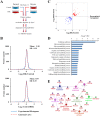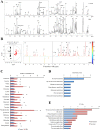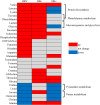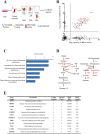Multi-omics analyses reveal metabolic alterations regulated by hepatitis B virus core protein in hepatocellular carcinoma cells
- PMID: 28112229
- PMCID: PMC5253728
- DOI: 10.1038/srep41089
Multi-omics analyses reveal metabolic alterations regulated by hepatitis B virus core protein in hepatocellular carcinoma cells
Abstract
Chronic hepatitis B virus (HBV) infection is partly responsible for hepatitis, fatty liver disease and hepatocellular carcinoma (HCC). HBV core protein (HBc), encoded by the HBV genome, may play a significant role in HBV life cycle. However, the function of HBc in the occurrence and development of liver disease is still unclear. To investigate the underlying mechanisms, HBc-transfected HCC cells were characterized by multi-omics analyses. Combining proteomics and metabolomics analyses, our results showed that HBc promoted the expression of metabolic enzymes and the secretion of metabolites in HCC cells. In addition, glycolysis and amino acid metabolism were significantly up-regulated by HBc. Moreover, Max-like protein X (MLX) might be recruited and enriched by HBc in the nucleus to regulate glycolysis pathways. This study provides further insights into the function of HBc in the molecular pathogenesis of HBV-induced diseases and indicates that metabolic reprogramming appears to be a hallmark of HBc transfection.
Figures







Similar articles
-
Hepatitis B virus core protein promotes hepatocarcinogenesis by enhancing Src expression and activating the Src/PI3K/Akt pathway.FASEB J. 2018 Jun;32(6):3033-3046. doi: 10.1096/fj.201701144R. Epub 2018 Jan 17. FASEB J. 2018. PMID: 29401603
-
A Pleiotropic Role of the Hepatitis B Virus Core Protein in Hepatocarcinogenesis.Int J Mol Sci. 2021 Dec 20;22(24):13651. doi: 10.3390/ijms222413651. Int J Mol Sci. 2021. PMID: 34948447 Free PMC article. Review.
-
Hepatitis B virus core protein stabilizes RANGAP1 to upregulate KDM2A and facilitate hepatocarcinogenesis.Cell Oncol (Dordr). 2024 Apr;47(2):639-655. doi: 10.1007/s13402-023-00889-4. Epub 2023 Oct 17. Cell Oncol (Dordr). 2024. PMID: 37845585
-
miR-106b promotes cancer progression in hepatitis B virus-associated hepatocellular carcinoma.World J Gastroenterol. 2016 Jun 14;22(22):5183-92. doi: 10.3748/wjg.v22.i22.5183. World J Gastroenterol. 2016. PMID: 27298561 Free PMC article.
-
Hepatitis B virus and microRNAs: Complex interactions affecting hepatitis B virus replication and hepatitis B virus-associated diseases.World J Gastroenterol. 2015 Jun 28;21(24):7375-99. doi: 10.3748/wjg.v21.i24.7375. World J Gastroenterol. 2015. PMID: 26139985 Free PMC article. Review.
Cited by
-
An Update on the Metabolic Landscape of Oncogenic Viruses.Cancers (Basel). 2022 Nov 23;14(23):5742. doi: 10.3390/cancers14235742. Cancers (Basel). 2022. PMID: 36497226 Free PMC article. Review.
-
The HBV Core Protein and Core Particle Both Bind to the PPiase Par14 and Par17 to Enhance Their Stabilities and HBV Replication.Front Microbiol. 2021 Dec 14;12:795047. doi: 10.3389/fmicb.2021.795047. eCollection 2021. Front Microbiol. 2021. PMID: 34970249 Free PMC article.
-
Deciphering hepatocellular carcinoma through metabolomics: from biomarker discovery to therapy evaluation.Cancer Manag Res. 2018 Apr 11;10:715-734. doi: 10.2147/CMAR.S156837. eCollection 2018. Cancer Manag Res. 2018. PMID: 29692630 Free PMC article. Review.
-
Generation and Utilization of a Monoclonal Antibody against Hepatitis B Virus Core Protein for a Comprehensive Interactome Analysis.Microorganisms. 2022 Nov 30;10(12):2381. doi: 10.3390/microorganisms10122381. Microorganisms. 2022. PMID: 36557634 Free PMC article.
-
Glucometabolic reprogramming: From trigger to therapeutic target in hepatocellular carcinoma.Front Oncol. 2022 Jul 15;12:953668. doi: 10.3389/fonc.2022.953668. eCollection 2022. Front Oncol. 2022. PMID: 35912218 Free PMC article. Review.
References
-
- Hanahan D. & Weinberg R. A. The hallmarks of cancer. Cell 100, 57–70 (2000). - PubMed
Publication types
MeSH terms
Substances
LinkOut - more resources
Full Text Sources
Other Literature Sources
Medical

